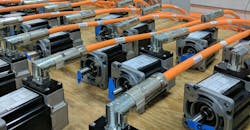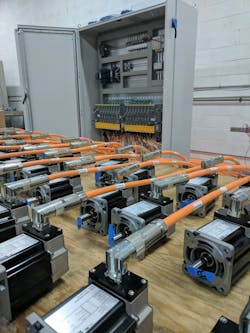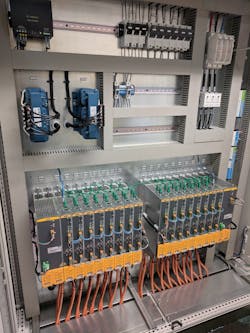36-Axis Servo Upgrade Improves Efficiency and Accuracy of Printing Press
A global packaging company operating a flexographic printing press in its Ontario facility needed to add higher-precision controls to it and improve its efficiency without taking it offline for too long. The company wanted expert help with the technical upgrade, so it called in Wainbee Limited, a systems integrator, for help.
The multicolor printer uses a large-diameter cylinder to support a substrate while it makes contact with a series of plate cylinders that apply successive colors. The press puts images on substrates that get affixed to corrugated boxes that carry a variety of products ranging from diapers to big-screen televisions.
In the scope of central impression—or "flexo”— printing, the press to be upgraded is among the largest. The 36-axis press has nine print decks with four axes and two cylinders per deck. It is about 150-ft long, 15-ft tall, and runs a 98-in. wide linerboard. Operators had to complete a mostly manual setup on the machine for each job.
Robert Cappuccitti, Wainbee’s technical services manager and product manager for electromechanical drives and controls, created a wish list for the upgrade based on years of experience upgrading central impression presses. His plan was to switch from the current open-loop stepper motors to a closed servo drive system.
All the servo drives installed for the upgrade (foreground) were tested before being installed. A Rittal enclosure (background) holds the common bus drives and controller.
Cappuccitti also wanted to include a multi-axis motion controller as the heart of the system; EtherCAT communication between the motion controller and servo drives; compact and common bus-style servo drives that offered STO (safe torque off); and reduced cabling between drive and servo motors such as Hiperface DSL. Ultimately, he wanted the controls for this upgrade to be used across several applications.
Cappuccitti was able to fulfill his wishlist with a range of electromechanical products from Parker Hannifin, including a PAC Controller, PSD Common Bus Servo Drives, MPP Servo Motor with Hiperface DSL feedback, and a Parker HMI Panel. He also selected a Wago controller and Scanreco transmitter and receiver to complete the package.
The Parker PSD servo system with Hiperface DSL feedback was ideal for this application. A fairly new technology, Hiperface DSL puts the power and feedback cables into one, cutting the total number of cables for the servos from 72 to 36. This simplified both installation and the overall machine design.
“Servos usually have two cables. One is a power cable that brings three-phase to the motor, and the other is the encoder feedback and it could be a number of other feedbacks as well,” says Cappuccitti. “So, if you’ve got 36 motors, then you’ve got 72 cables. That’s an enormous amount of cables.
A multi-axis motion PAC Controller from Parker Hannifin Corp. serves as the heart of the system with EtherCAT communications and compact, PSD Common Bus Servo Drive, also from Parker Hannifin.
“To tray that cable all the way back to the main computer can be a nightmare for several reasons,” he continues. “One is electrical noise. Encoder cables can't be near it, for example. To undertake a project like this, 72 cables would really not have been doable.”
Prior to installation, Cappuccitti and his team put the system through rigorous testing prior to installation to ensure the 70-ft runs of Hiperface DSL cabling would work with the cables all close to one another. The primary concern with power and control cables so close together with so many servos is that of creating a magnetic field. To avoid any problems, the team did long-term testing with no airgap between the cables.
“We mitigated the lack of downtime by getting our equipment in place as much as we could before we shut the machine down,” Cappuccitti recalls. “We fully tested it. All 36 motors were tested for several weeks before they left the shop.”
Hiperface DSL let engineers combine the power and feedback cabling to save space and installation time.
Ultimately Wainbee completed the onsite upgrade in two weeks—significantly less than the two months it would have taken to rebuild the printer with the same design it previously had. “That’s where this technology came into place; having that single-cable MPP Servo motor with Hiperface DSL to the PSD servo drive saved a lot of installation time and space.”
The upgraded printer permits repeatability and cut setup time by nearly 40% by eliminating the need for the operator to repeat the gauging process several times for each job. It also increased efficiency, accuracy, and print quality, and the safe torque off feature increased the printer’s safety. The new servo controls give the press operator more control over the process with a convenient wireless remote. Overall the packaging supplier was back online quickly with an improved press that lets it fulfill more orders.




